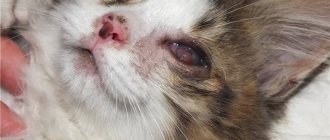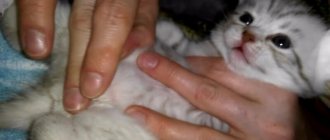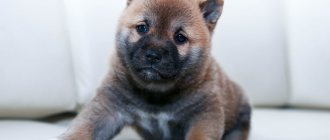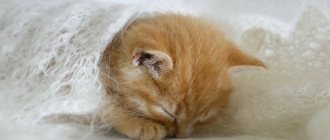Usually a four-legged friend appears in the owner’s house with his eyes open, but there are different situations. A domestic dog produces offspring or a kitten will be picked up on the street. In this case, it is important for a person to know all the stages of development of his four-legged friend in order to monitor the correct development in the first months of life.
Features of development
Despite appearances, a newborn puppy is not as helpless as it seems. Little dogs immediately smell and feel warmth. From the moment of birth until the opening of the eyes, the baby goes through a vegetative period, which is characterized by active growth. At this stage, it is possible to distinguish a weak representative from a strong one. More developed pets are the first to reach their mother's nipples, push their brothers aside, and gain weight faster.
The period from the day the chicks eyes open to the appearance of hearing is called awakening. On days 15-17, puppies of large and medium breeds try to stand on their paws. The next stage of development, adaptation, lasts until one month of age. But a lot depends on the dog’s breed, maintenance, feeding, and mother’s health.
Why do puppies have their eyes closed?
Closing the eyelids at birth protects little dogs from environmental influences. Dogs are predators by nature. When hunting, their especially valuable qualities are hearing and vision. That is why almost all representatives of this branch of the animal world are born blind and deaf. In this way, nature protects the most important elements of the health of the offspring.
Another reason is the birth of puppies not fully mature. This is due to the hunting purpose of dogs. Their ancestors led an active lifestyle during pregnancy. Heavy and large offspring could interfere with the process, so children were born in large numbers, but not mature.
At what age do puppies' eyes open?
Development in children does not occur in parallel. Puppies in the same litter begin to see and hear at different times. This is due to the characteristics of individual development. In many ways, the day when the puppies' eyes open depends on the due date. Post-term babies often begin to see and hear earlier.
This is interesting: Table of daily food intake depending on the age of the puppy
Normally, the time for epiphany is 10-15 days. The process takes place over several days. A small gap appears in the corner of the eyes. Then the eyelids gradually open. The dog begins to fully see the world in a month.
Obsessive neuroses
In most cases, the problem of obsessive-compulsive neurosis and tics is solved by play psychotherapy or a course of medical treatment, and most often by a combination of drug treatment and psychological work with suppressed nervous tension in the child.
Obsessive neuroses in children manifest themselves in the form of obsessive movements and thoughts. Obsessive states (obsessions) manifest themselves as irresistible and involuntarily arising thoughts, fears, and, as a result, obsessive movements.
Intrusive thoughts
- when a child fears for the health and safety of himself and his family
- constantly thinks or imagines that something bad might happen to them
- always remembers negative events that happened to him or his family in the past
Typical obsessive mental actions
- reading license plates, signs, operations with numbers and letters from license plates and signs
- counting lamp posts, houses, lawn fences, etc.
- constant search for “favorite” and “unfavorite” letters and numbers
Obsessive movements and actions.
The scope of their manifestations is very extensive. This could be a nervous tic in a child, or obsessive movements. The most typical obsessive movements and actions in children:
- biting nails and lips
- hair pulling
- thumb sucking, sucking or biting a pencil, pen, button, edge of clothing
- coughing, grunting, or making noises
- twitching of limbs
- blinking and/or stereotypic eye movements
- circling
- tapping, clapping
- rocking
- squatting, limping when walking
- rubbing the body or objects
- shaking and shaking hands and objects
- jumping and skipping for no reason
- muscle contractions of the arms and legs, as well as the face.
Typical complex ritual actions
- Children can walk on certain floor tiles
- walk around, twist, stroke the object a certain number of times
- jump up and clap your hands, pronounce phrases, etc.
Also, neuroses can have a different course:
- episodic
- chronic
- progressive
Neurosis in a child can have different causes
. The most common is the presence of any mental trauma in the child, as well as the presence of emotional factors. Such as: a tense and conflictual situation in the family, incorrect and too harsh and authoritarian upbringing of children.
Often this list also includes physiological reasons: heredity and genetics, previous diseases, physical overload of the child, lack of sleep.
One way or another, all this is due to the fact that the child has increased arousal in certain areas of the brain. Basically we are talking about dysfunction of the subcortical nuclei of the brain, which are responsible for posture and facial expressions, muscle tone and global motor acts. The child is forced to somehow relieve this excitement. Thus, this discharge occurs precisely through actions.
These may be: tics (the child twitches or jerks with some part of the body), fast stereotypical movements, there may be obsessive postures, obsessive movements; the child may sit down, jump, make some sounds, pronounce words or even swear words (with Tourette syndrome). Very often such manifestations are not taken seriously in the initial stages.
Tourette's syndrome is a genetically determined condition associated with obsessive-compulsive disorder and tics, or stereotypical tic-like movements.
Also, neurosis-like obsessive states are largely provoked by chronic streptococcal infection with an increase in antistreptolysin O (ASLO) in chronic tonsillitis, the so-called PANDAS syndrome, ongoing neuroinflammation with an increase in markers such as NSE and S100 protein. We also often see such manifestations in children who are carriers of neuroinfections, that is, infections that have a toxic effect on the nervous system.
EEG (electroencephalography) for children at the Echinacea clinic
We advise you to contact a child neurologist, child psychiatrist and allergist-immunologist. For convenience and coordination of assistance to the child, we practice a consultation of all three specialists. Thanks to this, the appointments are more informative, and the effect of the prescribed therapy occurs faster.
Obsessive neurosis responds well to treatment in the early stages, especially in preschool age.
As for Tourette's syndrome, even if there is a genetic predisposition, this syndrome can become silent. After all, until the debut of Tourette syndrome, the child lives with the same genetic makeup, but there are no tics or vocalisms. This is not only a matter of genetic predisposition to Tourette's syndrome, but also related problems and the current state of the child's health. Working with provoking factors (obsessive-compulsive disorder, infections, concomitant inflammatory diseases, sleep disturbances, high levels of anxiety, etc.) usually leads to gradual improvement, often until the complete cessation of tics and vocalisms.
We widely practice play therapy for the treatment of obsessive neuroses in children
Puppy development
Small pets begin to crawl after they open their eyes. At this time, they and their mother need to be placed in a separate enclosure, since the dogs fulfill their natural needs outside the place intended for their keeping.
Expert opinion
Anna Abramenko
An avid dog lover. Experience in veterinary medicine since 2009.
Ask a Question
Healthy puppies begin to walk at approximately 20 days of age. If the baby has not started walking by 30 days, you should contact a specialist.
Lack of hearing is more difficult to control. When a dog does not respond to sounds at the age of a month, this is a reason to go to the veterinarian.
The first liquid complementary foods should be introduced 2 weeks after the date of birth. Puppies can be given nutritious food when their baby teeth appear.
Interesting article: Changing teeth in puppies: at what age do puppies change their baby teeth
Expert opinion
Anna Abramenko
An avid dog lover. Experience in veterinary medicine since 2009.
Ask a Question
From the age of one month, the dog can already be instilled with basic concepts and begin to educate it.
Cause for concern
The following disorders should cause concern during the period of eye eruption in puppies:
- The dog's eyes did not open 3 weeks after birth,
- there is severe lacrimation,
- the eyelids of the kitten or the conjunctiva of the eyes are inflamed,
- the puppy's eyes fester.
If such symptoms are detected, the puppy must be taken to the veterinarian. He will examine the baby and find out the cause of the illness. In case of inflammation (blepharitis or conjunctivitis), the veterinarian will prescribe eye washes with freshly brewed warm tea, a decoction of chamomile, calendula, St. John's wort or Furacilin solution. If necessary, your puppy may be prescribed antibacterial and anti-inflammatory eye drops. For dogs, ophthalmic drugs Tsiprovet, Gentaline, Ophthalmostop, Trixie are used.
Sometimes, when examining a puppy, a congenital pathology is revealed, such as fusion of the eyelids, when the edges of the upper and lower eyelids are connected by a thin strip of skin. Dog breeds with folds on the muzzle are prone to this pathology: sharpeis, pugs, bulldogs, mastiffs, bloodhounds.
Eyelid fusion is considered physiological if it disappears on its own at the age of two weeks. If the puppy's eyelids do not separate after reaching this age, surgery may be required. The animal's eyelids are anesthetized with novocaine and carefully dissected along the fusion line. And to prevent them from connecting again, the eyelids are lubricated with boric vaseline for several days.
In any case, even if the puppies have received their sight in due time, and their eyes look quite healthy, at first, during the period of adaptation of the organ of vision, the puppies should be protected from too bright light. The muscles of the eyelids of canine cubs are still poorly developed and cannot effectively protect the eyeballs from negative influences, and the lacrimal glands are not yet able to secrete a sufficient amount of fluid necessary to flush the surface of the eyes and prevent the cornea from drying out.
- Until what age is a dog considered a puppy?
- False pregnancy (pregnancy) in dogs
- Dog pregnancy in detail by day
Possible problems
The reasons why puppies' eyes do not open can be:
- conjunctivitis;
- microbes getting into the gap between the eyelids;
- accumulation of specks and dirt on eyelashes.
The main symptom of eye problems is purulent discharge. To avoid further complications, it is necessary to treat these areas with one of these products:
- chamomile infusion;
- strong tea;
- furatsilin solution;
- antibiotic drops.
If the eyelids are fused, you should contact a veterinary clinic; surgery may be necessary. While there is no purulent discharge, you can try wiping your eyes daily with warm water.
What to do
Until the third week there is nothing to worry about, even if the whole litter is already learning to focus their eyes, and one is late and does not open his eyelids.
This is normal, it depends solely on personal characteristics.
The simplest option: the eyelids are simply stuck together due to dirt or dust. They just need a little help to open up. For this use:
- Warm water. It should be slightly warmer than body temperature and clean: preferably distilled, but you can just boil it.
- Chamomile decoction. Buy chamomile flowers at the pharmacy and brew the bag in boiling water for half an hour. Then let it cool.
- Miramestin. And other antiseptics that do not burn.
It is enough to wipe the baby’s eyes with all the ingredients six times a day. Dip a cotton pad into the composition, gently, slowly, so as not to harm, sweep over the eyelids.
It is strictly forbidden to use burning compounds, iodine and saline solutions.
Within two days of such therapy, the result should be visible. If it is not there and thin slits do not appear in the corners of the eyes, this means that something has gone wrong and you need to contact a veterinarian.
Most likely, the eyelids have either rolled up (this often happens in dogs that are covered with folds of skin), or have become very stuck together, or have begun to grow together. The doctor will separate them from each other in just half an hour - this operation does not require general anesthesia and is not considered dangerous.
If the baby develops conjunctivitis, which is obvious from the swelling of the eyelids and yellow pus appearing in the corners, you need to wipe his eyes with strong tea (you can even use a tea bag instead of a cotton pad) or the same antiseptics.
Puppy care
After opening, the dog begins to see after 2 weeks. At this time, special care is required for her. First of all, you should protect her eyes from bright light. Besides:
- If your pet is afraid to open his eyelids because of pain, it is enough to treat them with antiseptic solutions. This must be done until the dog fully recovers his sight.
- At first, when the eyes begin to open, it is worth rinsing. But the veterinarian prescribes medications for this.
This is interesting: Feeding frequency and daily food intake for dogs
In addition to vision, it is important to provide general care, which includes actions such as:
- tail docking, as required by the standard;
- deworming at 2 weeks;
- first vaccination.
Newborn puppies have blue eyes. The shade becomes natural later.
A whitish tone of the iris is a sign of vision problems.
The child does not sleep well at night, the child grinds his teeth (bruxism): a behavioral feature or a disease?
Getting a full night and daytime sleep every day is a very important condition for the development of mental functions of a preschool child. If your child begins to have trouble falling asleep and wakes up frequently, you should take this as carefully as possible. We are engaged in restoring normal sleep in children. Correction or treatment depends on the causes of sleep difficulties and is determined during a consultation or after a scheduled examination, if necessary.
How long should a child sleep?
| Child's age | Daytime sleep duration | Night sleep duration |
| 1 to 2 months | about 9 o'clock | around 18 o'clock |
| 3 to 4 months | about 8-6 hours | about 16 o'clock |
| 7 to 9 months | about 4 hours | about 13 o'clock |
| 10 to 12 months | about 3 hours | about 13 o'clock |
| From 1 to 1.5 years | about 3 hours | about 12 hours |
| From 1.5 to 2 years | about 2.5 hours | around 10-11 o'clock |
| From 2 to 3 years | about 2.5 – 2 hours | around 10-11 o'clock |
| From 3 to 7 years | about 1.5 hours, optional | about 10 o'clock |
| After 7 years | Daytime naps are not necessary | at least 8-9 hours |
Sleeping mode
. A child's normal sleep should proceed without interruption, without episodes of agitation associated with screaming or crying during sleep. The normal duration of falling asleep is about half an hour; if it lasts more than 30 minutes, you should pay attention to this and find out the reason. It is normal for a child to wake up early on weekends according to the routine adopted on weekdays. It is desirable that the biorhythm of the child’s life coincides with the biorhythm of the geographical time zone in which he lives. It is provided in nature that when it is dark outside, a person sleeps, and at dawn he wakes up, the same rhythm corresponds to the children's regime. For a preschooler, lights out should be no later than 10 p.m. It is not always possible for schoolchildren to maintain such a regime, because the load received at school increases disproportionately to the physiological capabilities of the children. But still, for the harmonious growth and development of a child, it is necessary to strive to adhere to the regime and have at least 8-9 hours of sleep. For a child under 10 years old, a sleep duration of 9-10 hours is absolutely normal and healthy.
Many children approaching school age refuse to sleep during the day; this is not always a violation of their sleep patterns; for some children, with a full night's sleep, the need for daytime sleep disappears. Provided that the lack of daytime sleep does not entail a change in the child’s well-being for the worse. One more aspect must be taken into account that for children under 4 years of age, daytime sleep is vital, since during this period of life the neural structure of the brain is actively being built and good sleep contributes to the most efficient functioning of the brain in the future.
Sleep consists of several stages (divided into phases). Complete rest, restoration of the nervous system, active metabolism and immunity occur mainly in the third and fourth phases of sleep. These phases are achieved only in night sleep, subject to timely falling asleep, sufficient duration and depth of sleep, and the absence of night awakenings.
A situation where a child does not sleep at night or
has difficulty falling asleep for a long time, often gets up, asks for something to drink or eat, or invents different activities for himself just to stay awake, can arise for many reasons.
Main reasons :
- increased intracranial pressure (ICP);
- increased level of anxiety;
- a stressful situation or excessive nervous tension in response to something;
- neurosis;
- excessive workload of the child at school;
- increased convulsive readiness of the cerebral cortex (recorded on the EEG);
- pain in the abdomen or other area of the body, itching, worms.
Behavioral factor.
It arises due to the attention deficit of adults who work all day and come home late, without devoting enough time to their child. As a result, the child falls asleep for a long time, because he wants to make up for the lack of communication with his parents and feel their physical and emotional presence next to him.
High level of anxiety in a child.
When a child cannot fall asleep, but having difficulty falling asleep, he often wakes up or sleeps shallowly, as the stress mechanisms of the nervous system continue to work, including defensive reactions and not allowing the child to fall asleep deeply.
The child screams in his sleep, walks, talks in his sleep.
Sleepwalking (somnambulism) is a state of incomplete awakening. At the time when the child should enter the deep stage of sleep, the process of brain inhibition occurs, but the process does not affect all areas of the brain, i.e. part of the brain remains awake or wakes up in the middle of the night. As a result, the child can sit up in bed, stand up, walk, scream, express emotions and even talk without waking up. Sleepwalking in children is usually quite treatable.
The child grinds his teeth in his sleep
. The main age when bruxism occurs is the period from 3 to 6 years. The peak of manifestation occurs at the age of five, when molars begin to erupt. The cause of teeth grinding can be difficulty breathing due to adenoids, ear or toothache and nasal congestion, abdominal pain and, in general, any physical discomfort.
Lack of adequate sleep can lead to serious problems for a child’s body. Such as a disorder of the nervous system, weakening of the immune system, disruption of the body’s usual mode of operation of all internal organs. It is necessary to treat your child's sleep as carefully as possible. Restoring normal night sleep in a child is, as a rule, a completely doable task.
treating a child who is not sleeping well first.
:
- Consultation with a pediatric neurologist. Typically, during the consultation, the cause of the sleep disorder will be clarified and treatment can be selected.
- If there are suspicions about chronic night pain anywhere, skin itching, nasal breathing problems, we will offer help from a doctor of the appropriate profile.
Useful tips
Beginning dog owners should know the tricks of raising healthy offspring:
- at first, up to 20-30 days, it is better to keep the offspring in twilight;
- You should not try to open the puppy’s eyes on your own, especially with dirty hands;
- You cannot bathe the baby; the bitch will provide him with hygiene herself.
By the age of one month, purebred puppies receive their first document - a puppy.
Two-day-old puppies look helpless, blind, and deaf. Therefore, initial care for them should be coordinated with a veterinarian. In addition, the breeder should know that pets cannot open their eyelids on their own. Otherwise, their eyes can become infected.











